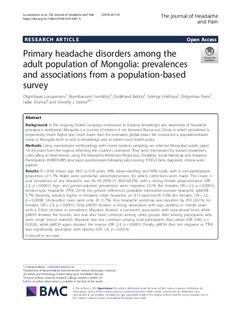| dc.contributor.author | Luvsannorov, O | |
| dc.contributor.author | Tsenddorj, Byambasuren | |
| dc.contributor.author | Baldorj, Dorjkhand | |
| dc.contributor.author | Enkhtuya, Selenge | |
| dc.contributor.author | Purev, Delgermaa | |
| dc.contributor.author | Thomas, Hallie | |
| dc.contributor.author | Steiner, Timothy J. | |
| dc.date.accessioned | 2020-01-13T10:08:42Z | |
| dc.date.available | 2020-01-13T10:08:42Z | |
| dc.date.created | 2020-01-09T10:24:58Z | |
| dc.date.issued | 2019 | |
| dc.identifier.issn | 1129-2369 | |
| dc.identifier.uri | http://hdl.handle.net/11250/2635898 | |
| dc.description.abstract | Background
In the ongoing Global Campaign endeavour to improve knowledge and awareness of headache prevalence worldwide, Mongolia is a country of interest. It sits between Russia and China, in which prevalence is, respectively, much higher and much lower than the estimated global mean. We conducted a population-based study in Mongolia both to add to knowledge and to inform local health policy.
Methods
Using standardized methodology with cluster random sampling, we selected Mongolian adults (aged 18–65 years) from five regions reflecting the country’s diversities. They were interviewed by trained researchers, cold-calling at their homes, using the Headache-Attributed Restriction, Disability, Social Handicap and Impaired Participation (HARDSHIP) structured questionnaire following pilot-testing. ICHD-3 beta diagnostic criteria were applied.
Results
N = 2043 (mean age 38.0 [±13.4] years, 40% urban-dwelling and 60% rural), with a non-participation proportion of 1.7%. Males were somewhat underrepresented, for which corrections were made. The crude 1-year prevalence of any headache was 66.1% (95% CI: 64.0–68.2%), with a strong female preponderance (OR: 2.2; p < 0.0001). Age- and gender-adjusted prevalences were: migraine 23.1% (for females, OR = 2.2; p < 0.0001); tension-type headache (TTH) 29.1% (no gender difference); probable medication-overuse headache (pMOH) 5.7% (trending towards higher in females); other headache on ≥15 days/month 5.0% (for females, OR = 2.2; p = 0.0008). Unclassified cases were only 35 (1.7%). Any headache yesterday was reported by 410 (20.1%; for females, OR = 2.4; p < 0.0001). Only pMOH showed a strong association with age, peaking in middle years with a 5-fold increase in prevalence. Migraine showed a consistent association with educational level, while pMOH showed the reverse, and was also more common among other groups than among participants who were single (never married). Migraine was less common among rural participants than urban (OR: 0.80; p = 0.0326), while pMOH again showed the reverse (OR: 2.4; p < 0.0001). Finally, pMOH (but not migraine or TTH) was significantly associated with obesity (OR: 1.8; p = 0.0214).
Conclusion
Headache disorders are common in Mongolia, with, most notably, a very high prevalence of headache on ≥15 days/month corroborated by the high prevalence of headache yesterday. The picture is very like that in Russia, and dissimilar to China. There are messages for national health policy. | nb_NO |
| dc.language.iso | eng | nb_NO |
| dc.publisher | BMC (part of Springer Nature) | nb_NO |
| dc.rights | Navngivelse 4.0 Internasjonal | * |
| dc.rights.uri | http://creativecommons.org/licenses/by/4.0/deed.no | * |
| dc.title | Primary headache disorders among the adult population of Mongolia: prevalences and associations from a population-based survey | nb_NO |
| dc.type | Journal article | nb_NO |
| dc.type | Peer reviewed | nb_NO |
| dc.description.version | publishedVersion | nb_NO |
| dc.source.volume | 20 | nb_NO |
| dc.source.journal | The Journal of Headache and Pain | nb_NO |
| dc.source.issue | 1 | nb_NO |
| dc.identifier.doi | 10.1186/s10194-019-1061-5 | |
| dc.identifier.cristin | 1769056 | |
| dc.description.localcode | © The Author(s). 2019 Open Access This article is distributed under the terms of the Creative Commons Attribution 4.0 International License (http://creativecommons.org/licenses/by/4.0/), which permits unrestricted use, distribution, and reproduction in any medium, provided you give appropriate credit to the original author(s) and the source, provide a link to the Creative Commons license, and indicate if changes were made. | nb_NO |
| cristin.unitcode | 194,65,30,0 | |
| cristin.unitname | Institutt for nevromedisin og bevegelsesvitenskap | |
| cristin.ispublished | true | |
| cristin.fulltext | original | |
| cristin.qualitycode | 1 | |

